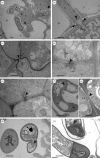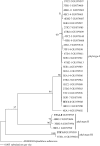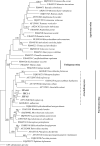Atractiellomycetes belonging to the 'rust' lineage (Pucciniomycotina) form mycorrhizae with terrestrial and epiphytic neotropical orchids
- PMID: 20007181
- PMCID: PMC2842812
- DOI: 10.1098/rspb.2009.1884
Atractiellomycetes belonging to the 'rust' lineage (Pucciniomycotina) form mycorrhizae with terrestrial and epiphytic neotropical orchids
Abstract
Distinctive groups of fungi are involved in the diverse mycorrhizal associations of land plants. All previously known mycorrhiza-forming Basidiomycota associated with trees, ericads, liverworts or orchids are hosted in Agaricomycetes, Agaricomycotina. Here we demonstrate for the first time that Atractiellomycetes, members of the 'rust' lineage (Pucciniomycotina), are mycobionts of orchids. The mycobionts of 103 terrestrial and epiphytic orchid individuals, sampled in the tropical mountain rainforest of Southern Ecuador, were identified by sequencing the whole ITS1-5.8S-ITS2 region and part of 28S rDNA. Mycorrhizae of 13 orchid individuals were investigated by transmission electron microscopy. Simple septal pores and symplechosomes in the hyphal coils of mycorrhizae from four orchid individuals indicated members of Atractiellomycetes. Molecular phylogeny of sequences from mycobionts of 32 orchid individuals out of 103 samples confirmed Atractiellomycetes and the placement in Pucciniomycotina, previously known to comprise only parasitic and saprophytic fungi. Thus, our finding reveals these fungi, frequently associated to neotropical orchids, as the most basal living basidiomycetes involved in mycorrhizal associations of land plants.
Figures




References
-
- Aime M. C., et al. 2007An overview of the higher-level classification of Pucciniomycotina based on combined analysis of nuclear large and small subunit rDNA sequences. Mycologia 98, 896–905 (doi:10.3852/mycologia.98.6.896) - DOI - PubMed
-
- Altschul S. F., Madden T. L., Schäffer A. A., Zhang J., Zhang Z., Miller W., Lipman D. J.1997Gapped BLAST and PSI-Blast: a new generation of protein database search programs. Nucleic Acids Res. 25, 3389–3402 (doi:10.1093/nar/25.17.3389) - DOI - PMC - PubMed
-
- Barroso J., Pais M. S.1985Cytochimie—caractérisation cytochimique de l'interface hôte/endophyte des endomycorrhizes d’Ophrys lutea. Rôle de l'hôte dans la synthèse des polysaccharides. Ann. Sci. Nat., Bot. 13, 237–244
-
- Bauer R., Oberwinkler F.1991The symplechosome: a unique cell organelle of some basidiomycetes. Botanica Acta 104, 93–97
-
- Bauer R., Begerow D., Sampaio J. P., Weiß M., Oberwinkler F.2006The simple-septate basidiomycetes: a synopsis. Mycol. Progr. 5, 41–66 (doi:10.1007/s11557-006-0502-0) - DOI
Publication types
MeSH terms
Substances
LinkOut - more resources
Full Text Sources
Molecular Biology Databases
